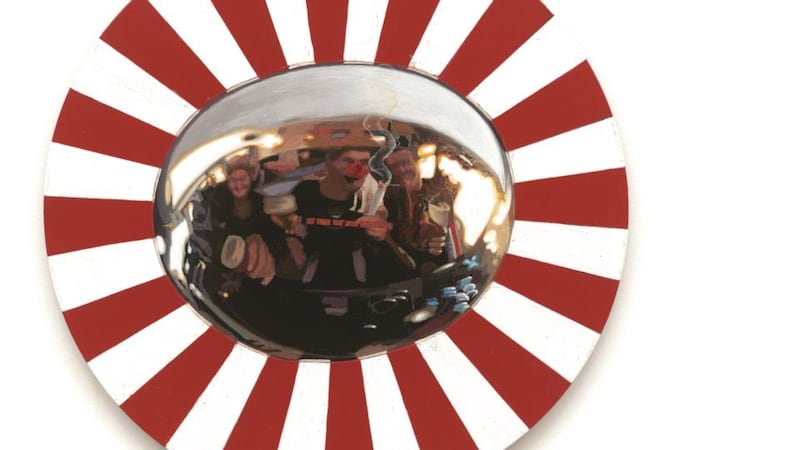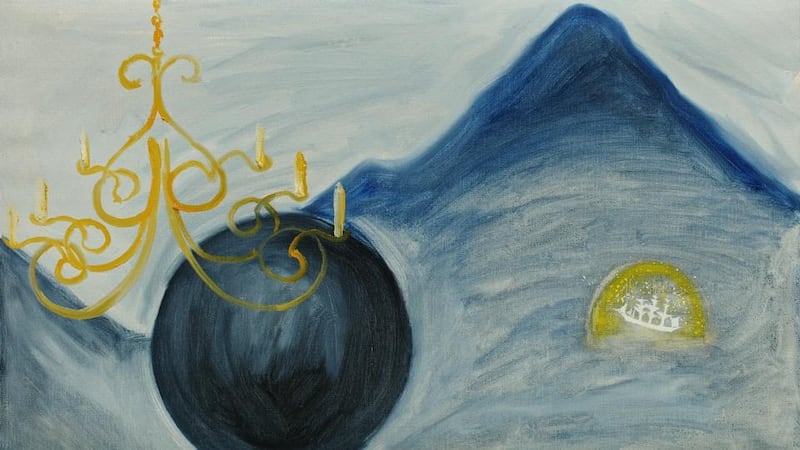Meraviglia (Marvel)
Three artists: Sandro Chia, Enzo Cucchi and Michael Warren
Hillsboro Fine Art, Dublin


*****
The trio of talents gathered at Hillsboro Fine Art for Meraviglia is indeed something of a marvel. Sandro Chia and Enzo Cucchi, two stars of the new figurative painting of the 1980s (known in Italy as the Transavantgardia), are joined by Irish sculptor Michael Warren.
Warren is best known as a maker of monumental abstract pieces, but his abstraction is thoroughly grounded in classical, humanist tradition and is metaphysically inclined. He also studied in Milan for several years and developed a lifelong love for Italian art from the Renaissance onwards and for the country’s wider cultural values. The show includes a stone carving he made in Milan during his time there: an impressive piece of work, which is, if you look carefully, a head.
All three artists share a love for and a debt to a great Italian tradition. There’s an allegorical quality to the work of both Chia and Cucchi. Cucchi’s background is in farming, by a port on the Adriatic; the imperatives of living close to the land and the sea, farming and fishing have long been at the heart of his paintings.
That remains true to this day, even though he has been based in Rome for many years. Despite his feeling for the hard graft of living off the land, he is not a social realist. In fact his pictorial language embraces a mythical, even magical vocabulary, shaped by the lore of earth and sea.
The human skull has been a favourite symbol but, he argues, it does not necessarily stand for death. “If you touch your head you feel the skull,” he says. It is, so to speak, reality. In a similar way he delights in animal imagery, invoking horses, fish, foxes and stags as symbolic presences in dreamlike landscapes. In his work we enter a world of fable.
That is also true of Chia, whose artistic pedigree is blue-chip: he’s from Florence, one of the centres of the Renaissance. He has an easy fluency with the classical idiom. There is a story that, in his early teens, he slipped and fell while fishing, hit his head on a rock and was unconscious for a week. When he awoke, he knew he wanted to be an artist. It could be true. By his own account, he later experimented with conceptualism and minimalism before returning to figurative painting with renewed vigour.
He developed a pictorial alter ego, a kind of heroic protagonist capable of adapting numerous guises, who features in innumerable paintings and whose experiences often reference myth and literature. That everyman figure is evident in his paintings at Hillsboro. In outline, it might sound as if his approach could become pompous or heavy-handed. In fact, Chia’s lightness of touch, economy of means and elegance imbue his art with real charm. He also has a sense of humour.
Apart from Warren’s early work, he exhibits several new wood sculptures. While all are weighty and substantial, they each deal with lightness and grace in a distinctive way. One is specifically identified as an altarpiece, but all of them seem open to interpretation within a religious or mystical context. The interconnections between all three artists are there, but never forced – each gets a room to himself. It adds up to a thoroughly enjoyable show.
[ hillsborofineart.comOpens in new window ]
LP: Catherine Barron
The Molesworth Gallery, Dublin
*****
As the name of the exhibition might suggest, many of Catherine Barron’s works are painted directly on to LPs. That might sound a bit gimmicky, but it’s anything but. This is an intensely personal body of work, beautifully made, multilayered and richly detailed. She has a track record of painting on to previously used surfaces, including salvaged metal plates, old book covers and vintage erotica, and she has previously worked from an archive of family photographs.
There's a photographic quality to the optics of the imagery in LP as well, but a slightly deceptive one. While it looks as if Barron has employed a fisheye lens for her source photographs, she has in fact used the shiny convex bowl of a silver spoon to reflect the images. The imagery features, mostly, her in her studio. There is an element of self-obsession, because the paintings are intimately autobiographical, but she's a tough, scrupulous observer of her own story, and there's no easy sentiment.
She echoes the circular frame of the records with her fishbowl images. Allied to the repetitive nature of the subject, a certain claustrophobia is suggested, appropriate given that the work is, in a sense, about being inside one's own head. MC Escher's celebrated self-portrait Hand with Reflecting Sphere is a good point of reference. In an accompanying publication, Lone Play, it emerges that the works chart the break-up of a relationship: the first piece is titled Draw Blood and the last Standing on My Own Two Feet.
With a profusion of floral motifs, mostly roses and rose petals, and a wealth of other indicative elements, the musical dimension and musical memories embodied in the LPs come into focus.
While not all the works are painted on LPs, the circular format is maintained in a fine suite of nine paintings on LP sleeve-sized panels of MDF. Again echoing Escher, virtually every piece has the intricacy, even the delicacy, of a miniature, with abundant, telling detail. The closer you look the more you see, and it all contributes to the integrity of the overall project. You never feel Barron is straining to be clever, but clever she is.











